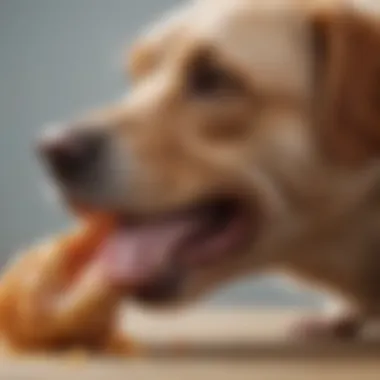Unveiling the Enigmatic Role of Raw Chicken Heads in Canine Nutrition


Animal Species Profile
When considering the feeding practices of domestic dogs, the topic of raw chicken heads often emerges as a point of contention. While some pet owners swear by its benefits, others raise concerns about potential risks. Understanding the implications of incorporating raw chicken heads into a canine's diet requires a deep dive into the nutritional value, safety considerations, and overall impact on the health of our beloved furry companions.
Albeit controversial, the practice of feeding raw chicken heads to dogs has garnered attention due to the purported benefits it offers. Advocates suggest that raw chicken heads can provide essential nutrients that may be lacking in commercial dog food diets. Conversely, skeptics worry about the potential for bacterial contamination and the risks associated with bones in the raw meat. As such, exploring the pros and cons becomes imperative to make informed decisions regarding our pets' well-being.
Unique Facts & Trivia
Engaging in the practice of feeding raw chicken heads to dogs unveils various lesser-known facts and insights. One interesting aspect to consider is the impact of ancestral diet on dogs' current nutritional requirements. Historically, canines are meat-eaters, and raw food proponents argue that raw chicken heads mimic a diet more akin to what dogs would naturally consume in the wild. Such perspectives shed light on the evolutionary biology of dogs and their affinity towards raw, unprocessed foods.
Moreover, the concept of functional morphology plays a role in understanding why some pet owners opt for raw chicken heads as part of their dogs' diets. Dogs possess jaw structures and teeth designed for tearing and crunching bones, showcasing an evolutionary adaptation to semi-carnivorous eating habits. By feeding raw chicken heads, some argue that pets can exercise their jaws and maintain dental health as they would in the wild, fostering a sense of instinctual behavior.
Additionally, exploring the nutritional composition of raw chicken heads reveals surprising nourishment profiles. Rich in protein, healthy fats, vitamins, and minerals, raw chicken heads present a holistic dietary option that aligns with dogs' dietary requirements. This nutrient density coupled with the oral stimulation of chewing bones provides dogs with both physical and mental benefits, promoting overall well-being and satisfaction.
Pet Care & Tips
For pet owners contemplating the inclusion of raw chicken heads in their dogs' diets, several considerations must be taken into account to ensure responsible and informed decision-making. Consulting with a veterinarian who is well-versed in raw feeding practices can offer valuable insights tailored to the specific nutritional needs of individual pets. Additionally, sourcing high-quality, organic chicken heads from reputable suppliers is crucial to minimize the risks of bacterial contamination and ensure the safety of the raw diet.
Furthermore, incorporating raw chicken heads should be part of a balanced and varied diet for dogs. Supplementing with other essential nutrients, such as fruits, vegetables, and grains, can help meet dogs' overall dietary requirements and prevent any nutritional imbalances. Monitoring the pets' health and well-being, observing for any adverse reactions or sensitivities, is paramount when introducing new food items to their diet.
In essence, delving into the realm of feeding raw chicken heads to dogs necessitates a nuanced understanding of the nutritional, behavioral, and health-related aspects involved. By being well-informed, proactive, and attentive to the needs of our beloved furry companions, we can navigate this controversial terrain with care and consideration, placing the well-being of our pets at the forefront.
Introduction
The controversial practice of feeding raw chicken heads to dogs has sparked ongoing debates among pet owners, veterinarians, and animal nutrition experts. As a key aspect of canine dietary discussions, the role of raw chicken heads in a dog's nutrition is a topic of great interest and scrutiny. This article aims to delve into the intricacies of this contentious issue, shedding light on the potential benefits, risks, and considerations associated with incorporating raw chicken heads into a dog's diet.
Understanding the Debate
The controversy surrounding raw feeding
In the realm of canine nutrition, the controversy surrounding raw feeding revolves around the fundamental disagreement on whether raw diets, including raw chicken heads, provide optimal nutrition for dogs. Proponents argue that raw diets mirror dogs' ancestral dietary patterns, promoting better health and vitality. However, critics express concerns regarding the risks of bacterial contamination, nutritional imbalances, and potential health hazards associated with feeding raw foods. Despite the contrasting viewpoints, the controversy surrounding raw feeding underscores the need for informed decision-making when it comes to choosing the best nutrition for our beloved pets.
Various perspectives on raw diets for dogs


Various perspectives on raw diets for dogs offer a kaleidoscope of opinions on the efficacy and safety of raw feeding practices. Some advocates emphasize the natural and biologically appropriate nature of raw diets, citing improvements in coat condition, energy levels, and overall well-being in dogs. Conversely, skeptics caution against the lack of scientific evidence supporting the benefits of raw diets and raise concerns about the potential risks of pathogens present in raw meat. By exploring these divergent viewpoints, pet owners can gain a comprehensive understanding of the complex landscape surrounding raw diets and make informed choices for their canine companions.
Overview of Raw Chicken Heads
Nutritional composition of raw chicken heads
The nutritional composition of raw chicken heads offers a rich array of essential nutrients vital for a dog's health and well-being. Protein, a cornerstone of canine nutrition, is abundant in raw chicken heads, supporting muscle development and repair. Additionally, chicken heads are a natural source of vitamins and minerals, including Vitamin A, Vitamin K, and calcium, which play pivotal roles in maintaining various physiological functions in dogs. Understanding the nutrient profile of raw chicken heads is essential in evaluating their efficacy as a dietary supplement for canine dietary needs.
Common reasons for including raw chicken heads in a dog's diet
Pet owners opt to include raw chicken heads in their dog's diet for a multitude of reasons, ranging from dental health benefits to palatability. The mechanical action of chewing on raw chicken heads can help in naturally cleaning a dog's teeth, reducing plaque buildup, and promoting better oral hygiene. Moreover, the nutrient-dense nature of chicken heads appeals to those seeking to offer their pets a whole-food source of nutrition. By exploring the common reasons behind incorporating raw chicken heads into a dog's diet, pet owners can make well-informed choices that align with their furry companion's nutritional requirements and overall well-being.
Benefits of Raw Chicken Heads
Raw chicken heads offer a plethora of advantages for dogs, making them a valuable addition to their diet. The high nutritional value of raw chicken heads makes them a commendable source of essential nutrients for canine health. Packed with protein, vitamins, and minerals, these chicken heads contribute significantly to a well-rounded canine diet. Additionally, the texture and consistency of raw chicken heads provide a natural chewing experience that promotes dental health by reducing plaque and tartar buildup. Incorporating raw chicken heads into a dog's diet can enhance their overall well-being and vitality.
Rich Source of Essential Nutrients
Protein content in raw chicken heads
The protein content in raw chicken heads serves as a fundamental component of a dog's diet. Dogs require adequate protein for muscle development, tissue repair, and overall growth. Raw chicken heads present a highly digestible protein source that supports the maintenance of lean muscle mass and enhances energy levels in dogs. The amino acids found in chicken heads are essential for various physiological functions, ensuring optimal health and vitality. When sourced responsibly and included in appropriate quantities, the protein in raw chicken heads can positively impact a dog's overall health and well-being.
Vitamins and minerals present in chicken heads
Raw chicken heads contain a diverse range of vitamins and minerals that contribute to a dog's overall nutritional requirements. Vitamins such as A, B6, and C play crucial roles in immune function, skin health, and metabolism. Minerals like calcium, phosphorus, and iron are essential for bone strength, dental health, and oxygen transport within the body. By incorporating raw chicken heads into a dog's diet, pet owners can ensure their furry companions receive a balanced array of essential nutrients that support longevity and vitality.
Promotes Dental Health
Mechanical cleaning action of chewing on chicken
heads
The act of chewing on raw chicken heads provides dogs with a natural dental cleaning mechanism. The fibrous texture of the chicken heads helps scrape away plaque and tartar from the teeth, promoting oral hygiene and preventing dental issues. Regular chewing on raw chicken heads can improve gum health, reduce bad breath, and enhance overall dental hygiene in dogs. This mechanical cleaning action mimics the natural behavior of gnawing on bones, which has been historically beneficial for canine dental health.
Reduction of plaque and tartar buildup


By engaging in the act of chewing on raw chicken heads, dogs can experience a significant reduction in plaque and tartar buildup on their teeth. The abrasive texture of the chicken heads helps dislodge debris and biofilm present on the tooth surface, preventing the formation of dental calculus. This reduction in plaque accumulation decreases the risk of periodontal disease and helps maintain optimal oral health in dogs. Regular consumption of raw chicken heads can contribute to fresher breath, healthier gums, and improved overall dental well-being.
Risks and Safety Concerns
Bacterial Contamination
Bacterial contamination poses a significant threat when considering the consumption of raw chicken heads by dogs. The presence of pathogens such as Salmonella and E. coli can lead to severe health consequences for our pets. Recognizing the impact of bacterial contamination on canine well-being underscores the importance of stringent safety measures.
Salmonella and E. coli risks
Exploring the specific risks linked to Salmonella and E. coli highlights the underlying hazards of feeding raw chicken heads to dogs. These pathogens have the potential to cause foodborne illnesses, resulting in gastrointestinal distress and other complications. Mitigating the prevalence of Salmonella and E. coli within raw diets is crucial to safeguarding the health of our furry friends.
Issues related to inadequate handling and storage
Inadequate handling and storage of raw chicken heads can exacerbate the risks of bacterial contamination. Poor hygiene practices and improper storage conditions can escalate the likelihood of pathogen transmission. Addressing the issues surrounding handling and storage is key to minimizing the impact of bacterial contamination on canine health.
Choking Hazards
Apart from bacterial concerns, choking hazards represent another critical aspect to consider when feeding raw chicken heads to dogs. The risk of choking on bones poses a serious threat to their well-being, necessitating vigilant supervision and precautionary measures to avert potential incidents.
Potential risks associated with bones
Bones in raw chicken heads can present a choking hazard due to their size and structure. Dogs may struggle to consume large bones, increasing the risk of obstruction in the airway. Assessing and addressing these risks is crucial to prevent choking incidents and promote safe feeding practices.
Precautionary measures to prevent choking incidents
Implementing precautionary measures is essential to reduce the likelihood of choking incidents during feeding sessions. Supervision plays a pivotal role in ensuring that dogs chew and ingest chicken heads safely. Incorporating appropriate feeding practices and precautions can mitigate the risks associated with bone consumption.
Guidelines for Feeding Raw Chicken Heads
Guidelines for Feeding Raw Chicken Heads is a crucial aspect of this article, shedding light on the safe and appropriate ways to incorporate raw chicken heads into a dog's diet. Understanding how to introduce this food item responsibly can significantly impact a dog's well-being. By following established guidelines, pet owners can ensure that their furry companions receive the necessary nutrients without exposing them to undue risks. Emphasizing the importance of balancing nutritional benefits with potential hazards, these guidelines serve as a roadmap for navigating the complexities of raw feeding. Pet owners seeking to optimize their dog's diet will find valuable insights in this section.
Consultation with Veterinarian


Importance of seeking professional advice
The Importance of seeking professional advice cannot be overstated when it comes to navigating the intricacies of raw feeding. Veterinarians play a pivotal role in guiding pet owners towards informed decisions that align with their dog's specific dietary requirements. By consulting with a vet, pet owners can access tailored recommendations that consider their dog's age, breed, health condition, and individual nutritional needs. This collaboration ensures a holistic approach to pet care, promoting optimal health outcomes and preventing potential dietary imbalances. Seeking professional advice empowers pet owners to make decisions based on expert knowledge, fostering a proactive stance towards their dog's well-being.
Customizing the diet to meet individual dog's needs
Customizing the diet to meet individual dog's needs is an essential component of responsible pet ownership. Every dog is unique, with distinct dietary preferences and requirements. Tailoring a dog's diet to suit their specific needs involves a thoughtful blend of proteins, fats, carbohydrates, vitamins, and minerals. By customizing the diet, pet owners can address any deficiencies or allergies, promoting a balanced and wholesome eating experience for their furry companion. This personalized approach not only enhances the dog's overall health but also strengthens the bond between pet and owner through attentive care and consideration. Pet owners embarking on the raw feeding journey must prioritize customization to ensure optimal nutritional intake for their beloved canine.
Precautions to Take
Safe sourcing of raw chicken heads
Ensuring the safe sourcing of raw chicken heads is paramount in mitigating potential health risks associated with raw feeding. Pet owners must select reputable suppliers known for their adherence to quality standards and hygiene practices. Prioritizing local and trusted sources reduces the chances of contamination and guarantees the freshness and safety of the food being provided to dogs. By scrutinizing the sourcing process, pet owners can safeguard their furry companions against bacterial infections and other food-related ailments, instilling confidence in the quality of the ingredients consumed. Safe sourcing practices underscore a pet owner's commitment to upholding high standards of food safety and animal care, reflecting a proactive stance towards pet health.
Supervision during feeding sessions
Supervision during feeding sessions plays a critical role in ensuring the well-being of dogs engaged in raw feeding. The act of consuming raw chicken heads requires attentive monitoring to prevent choking incidents and promote safe eating habits. Pet owners should closely observe their dogs while they consume this food item, intervening if any issues arise to prevent accidental ingestion of bones or other hazardous elements. Through vigilant supervision, pet owners can create a secure feeding environment that minimizes risks and maximizes their dog's safety and enjoyment. This hands-on approach fosters a deeper connection between pet and owner, fostering mutual trust and care in the feeding process. Pet owners investing time and attention in supervising feeding sessions demonstrate a commitment to their dog's welfare and promote responsible raw feeding practices.
Conclusion
Feeding raw chicken heads to dogs is a topic that sparks intense debate within the pet community. As owners seek to provide the best nutrition for their furry companions, the decision to incorporate raw chicken heads in a dog's diet requires careful consideration and evaluation of the associated risks and benefits. Considering the nutritional composition, safety concerns, and potential impact on canine health is essential in making an informed choice. By weighing the advantages and disadvantages of raw chicken heads as a dietary option, pet owners can make decisions that align with their pet's well-being. Additionally, exploring alternative dietary options allows owners to tailor their dog's nutrition to meet specific health needs and preferences. By understanding the implications of raw chicken heads and other feeding choices, pet owners can make conscientious decisions that promote the overall health and longevity of their beloved companions.
Balancing Risks and Benefits
Weighing the pros and cons of raw chicken heads
When evaluating the pros and cons of incorporating raw chicken heads into a dog's diet, pet owners must consider the nutritional benefits against the associated risks. The high protein content and essential nutrients present in raw chicken heads can contribute significantly to a dog’s overall health. However, potential bacterial contamination, such as Salmonella and E.coli, poses a risk that owners should be mindful of. Understanding the unique nutritional profile of raw chicken heads and its potential benefits can empower pet owners to make informed decisions regarding their pet's diet.
Considering alternative dietary options
In considering alternative dietary options, pet owners can explore a variety of nutritionally balanced choices that cater to their dog's individual needs. Whether opting for commercial dog food, homemade meals, or cooked diets, each alternative has its advantages and disadvantages. Commercial dog food offers convenience and balanced nutrition, while homemade diets allow for customization and control over ingredients. Exploring these alternatives enables pet owners to make choices that best suit their dog's health requirements and dietary preferences.
Final Thoughts
Making informed decisions for your dog's health
In the realm of pet nutrition, making informed decisions is crucial for ensuring the well-being of furry companions. Pet owners should stay informed about the latest research and recommendations regarding canine dietary needs. Consulting with veterinarians or pet nutritionists can provide valuable insights and guidance in crafting a diet that promotes optimal health and longevity for dogs. By staying proactive and knowledgeable, pet owners can prioritize their dog's health and make choices that align with their pet's specific nutritional requirements.
Impact of individual dog's health conditions
Understanding the impact of individual health conditions on a dog's dietary needs is paramount in maintaining their overall wellness. Dogs with specific health concerns, such as allergies, sensitivities, or digestive issues, may require specialized diets tailored to address their unique conditions. By acknowledging and addressing individual health requirements, pet owners can proactively support their dog's well-being and quality of life. Tailoring dietary choices to accommodate individual health conditions underscores the importance of personalized nutrition in enhancing the health and vitality of canine companions.







